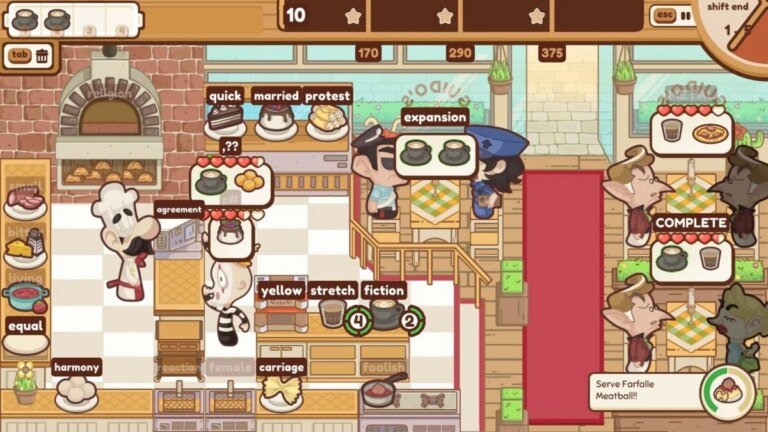
When I try to use my mouse in The Chef’s Shift, a stern reminder pops up on the screen: Use your keyboard! Though The Chef’s Shift may look like the classic restaurant management games Diner Dash or Cake Mania, it’s got a distinct twist: You don’t use a controller or mouse at all. It’s all controlled by keyboard typing. If a pizzeria customer asks for pasta with pesto, that means typing the word above the pasta noodles, then the pesto sauce. Typing another word, above the customer’s head, delivers it to their table. Then another word to pay at the cash register.
The Chef’s Shift begins simply, largely serving different coffees and cakes in the bustling pizzeria. Soon, customers will begin asking for pepperoni pizza, fried rice balls, or different noodle dishes. It quickly becomes chaos: Touch typing—without looking down at the keyboard—becomes essential in making sure your pizzas don’t burn and customers stay happy. Mice scuttle in here and there looking to steal food and disrupt service—so type the two letters above their head to shoot them with a gun. From the pizza restaurant, The Chef’s Shift opens up into a Chinese dumpling house, a Mexican restaurant, and a Korean barbeque house. Underlying it all is a dramatic soap opera story that starts with a criminal disguising himself as the Italian chef and blooming into a wide-ranging story involving international crime, love (and love triangles), lost memories, and family drama.
It’s been a good year for typing games: Final Sentence, a typing battle royale; Blood Typers, which blends survival horror with typing mechanics; and Dead Letter Dept., featuring the horrors of data entry, all were released this year. Typing game makers are pushing the boundaries of what typing games can be or have been, and The Chef’s Shift is part of that trend. A lot of traditional typing games, think Type Racer or Z-Type, bank on your typing speed—if you go fast, you’ll succeed. You certainly need to be a decently proficient typist to play The Chef’s Shift, but it’s more about thinking quickly by determining the right method of prioritizing orders. Some dishes have a cook time, and others have more complicated steps (takoyaki, for instance, requires a bunch of singular button presses to fill the mold, add fillings, and flip the octopus balls) or built-in minigames, like matching color patterns for mochi balls. Don’t even get me started on the patrons who change their orders.
On top of that, the stuff you need to type gets continuously more challenging. Businessmen only use numbers, while furries only speak in emoticons, for instance. It’s especially hard to keep track of all the different symbols on the keyboard while panicking that your meat is burning; of course, there are accessibility settings to turn off the use of symbols, numbers, and caps lock.
The Chef’s Shift has compelling enough typing elements to stand on its own without an overarching narrative, but the ridiculous, dramatic story ends up being a perfect backdrop. Come for the typing, stay for the telenovela.


